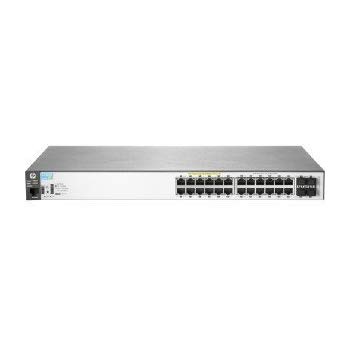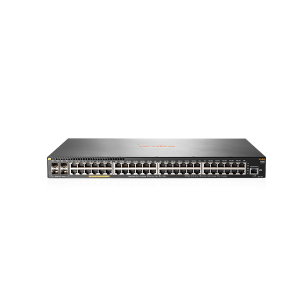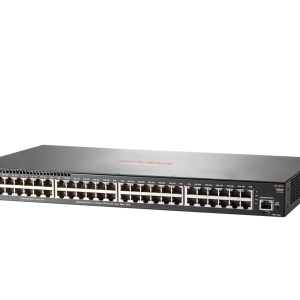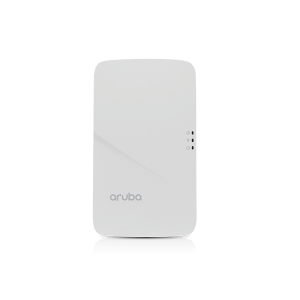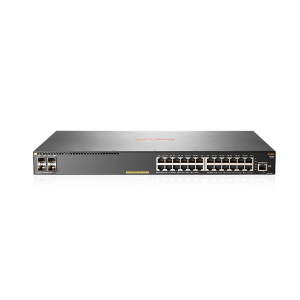Description
Features and Benefits:
Quality of Service (QoS)
- Traffic prioritization (IEEE 802.1p) allows real-time traffic classification with support for eight priority levels mapped to either two or four queues, and uses weighted deficit round robin (WDRR) or strict priority
- Simplified quality of service (QoS) configuration
- Port-based prioritizes traffic by specifying a port and priority level
- VLAN-based prioritizes traffic by specifying a VLAN and priority level
- Class of Service (CoS) sets the IEEE 802.1p priority tag based on IP address, IP Type of Service (ToS), Layer 3 protocol, TCP/UDP port number, source port, and DiffServ
- Rate limiting establishes per-port ingress-enforced maximums for all ingressed traffic or for broadcast, multicast, or unknown destination traffic
- Layer 4 prioritization enables prioritization based on TCP/UDP port numbers
- Flow control helps deliver reliable communication during full-duplex operation
Management
- NEW Zero-Touch ProVisioning (ZTP) uses settings in DHCP to enable ZTP with Aruba AirWave Network Management
- Choice of management interfaces
- HTML-based easy-to-use Web GUI allows configuration of the switch from any Web browser
- Robust CLI provides advanced configuration and diagnostics
- Simple network management protocol (SNMPv1/v2c/v3) allows the switch to be managed with a variety of third- party network management applications
- Virtual stacking provides single IP address management for up to 16 switches
- sFlow® (RFC 3176) delivers wire-speed traffic accounting and monitoring, configured by SNMP and CLI with three terminal encrypted receivers
- IEEE 802.1AB Link-Layer Discovery Protocol (LLDP) automates device discovery protocol for easy mapping by network management applications
- Logging provides local and remote logging of events via SNMP (v2c and v3) and syslog; provides log throttling and log filtering to reduce the number of log events generated
- Port mirroring allows traffic to be mirrored on any port or a network analyzer to assist with diagnostics or detecting network attacks
- Remote monitoring (RMON) provides advanced monitoring and reporting capabilities for statistics, history, alarms, and events
- Friendly port names allows assignment of descriptive names to ports
- Dual flash images provides independent primary and secondary operating system files for backup while upgrading
- Multiple configuration files are easily stored with a flash image
- Front-panel LEDs
- Locator LEDs allows users to set the locator LED on a specific switch to turn on, blink, or turn off; and simplifies troubleshooting by making it easy to locate a particular switch within a rack of similar switches
- Per-port LEDs provides an at-a-glance view of the status, activity, speed, and full-duplex operation
- Power and fault LEDs display issues, if any
- HPE Comware CLI
- Comware-compatible CLI bridges the experience of HPE Comware CLI users who are using the HPE ProVision software CLI
- Display and fundamental Comware CLI commands are embedded in the switch CLI as native commands; display output is formatted as on Comware-based switches, and fundamental commands provide a Comware-familiar initial switch setup
- Configuration Comware CLI commands when Comware commands are entered, CLI helps elicit to formulate the correct ProVision software CLI command
- Download Software via DHCP adds the option to specify the location of switch software via DHCP
- TR-069 support enables zero-touch configuration for switches
Connectivity
- IPv6
- IPv6 host allows the switch to be deployed and managed at the edge of an IPv6 network
- Dual stack (IPv4/IPv6) supports connectivity for both protocols; provides a transition mechanism from IPv4 to IPv6
- MLD snooping forwards IPv6 multicast traffic to appropriate interface; prevents IPv6 multicast traffic from flooding the network
- IPv6 ACL/QoS supports ACL and QoS for IPv6 network traffic on Gigabit and 48 port 10/100 models
- Security RA Guard, DHCPv6 Protection, Dynamic IPv6 Lockdown (YA only)
- IEEE 802.3af Power over Ethernet (PoE) provides up to 15.4 W per port to IEEE 802.3af-compliant PoE-powered devices such as IP phones, wireless access points, and security cameras
- IEEE 802.3at PoE+ provides up to 30 W per port to IEEE 802.3 for PoE/PoE+-powered devices such as video IP phones, IEEE 802.11n wireless access points, and advanced pan/tilt/zoom security cameras (refer to the product specifications for the total PoE power availability)
- Auto-MDIX adjusts automatically for straight-through or crossover cables on all ports
- Pre-standard PoE support detects and provides power to pre-standard PoE devices (refer to the list of supported devices in the product FAQs, which can be accessed at www.hpe.com/networking/support)
- SFP slots provides fiber connectivity such as Gigabit-SX, LX, LH, and BX with four SFP slots on all 24- and 48-port Gigabit Ethernet models. Fast Ethernet 24- and 48-port models have two SFP slots and two RJ-45 Gigabit uplinks; 8-port models have two dual-personality ports supporting either SFP or RJ-45 Gigabit uplinks
- Dual-personality (RJ-45 or USB micro-B) serial console port gives easy access to switch CLI with front-of-switch location and the flexibility of using either an RJ-45 or USB micro-B serial console port
Layer 2 switching
- VLANs provides support for 512 VLANs and 4,094 VLAN IDs
- Jumbo packet support supports up to 9,220-byte frame size to improve the performance of large data transfers; 8- and 24-port Fast Ethernet models automatically support up to 2,000-byte frames with no configuration needed
- 16K MAC address table provides access to many Layer 2 devices
- GARP VLAN Registration Protocol allows automatic learning and dynamic assignment of VLANs
- Rapid Per-VLAN Spanning Tree (RPVST+) allows each VLAN to build a separate spanning tree to improve link bandwidth usage; is compatible with PVST+
Security
- ACLs accommodates IPv4/IPv6 port and VLAN-based ACLs (IPv6 ACL is supported only on Gigabit Ethernet and 48- port models.)
- Source-port filtering allows only specified ports to communicate with each other
- RADIUS/TACACS+ eases switch management security administration by using a password authentication server
- Secure Sockets Layer (SSL) encrypts all HTTP traffic, allowing secure access to the browser-based management GUI in the switch
- Port security allows access only to specified MAC addresses, which can be learned or specified by the administrator
- MAC address lockout prevents particular configured MAC addresses from connecting to the network
- Multiple user authentication methods
- IEEE 802.1X uses an IEEE 802.1X supplicant on the client in conjunction with a RADIUS server to authenticate in accordance with industry standards
- Web-based authentication provides a browser-based environment, similar to IEEE 802.1X, to authenticate clients that do not support the IEEE 802.1X supplicant
- MAC-based authentication authenticates the client with the RADIUS server based on the client’s MAC address
- Secure shell (SSH) v2 encrypts all transmitted data for secure remote CLI access over IP networks
- Secure shell encrypts all transmitted data for secure remote CLI access over IP networks
- STP BPDU port protection blocks Bridge Protocol Data Units (BPDUs) on ports that do not require BPDUs, preventing forged BPDU attacks
- STP root guard protects the root bridge from malicious attacks or configuration mistakes
- Secure management access delivers protected encryption of all access methods (CLI, GUI, or MIB) through SSHv2 and SNMPv3
- Custom banner displays security policy when users log in to the switch
- Secure FTP allows secure file transfer to and from the switch; protects against unwanted file downloads or unauthorized copying of a switch configuration file
- Protected ports CLI offers intuitive CLI to configure the source-port filter feature, by allowing specified ports to be isolated from all other ports on the switch; the protected port or ports can communicate only with the uplink or shared resources
- Authentication flexibility
- Multiple IEEE 802.1X users per port provides authentication for up to 32 IEEE 802.1X users per port; prevents a user from “piggybacking” on another user’s IEEE 802.1X authentication
- Concurrent IEEE 802.1X and Web or MAC authentication schemes per port allows a switch port to accept any IEEE 802.1X and either Web or MAC authentications
- Switch management logon security helps secure switch CLI logon by optionally requiring either RADIUS or TACACS+ authentication
- DHCP protection blocks DHCP packets from unauthorized DHCP servers, preventing denial-of-service attacks
- Dynamic ARP protection blocks ARP broadcasts from unauthorized hosts, preventing eavesdropping or theft of network data
- Dynamic IP lockdown works with DHCP protection to block traffic from unauthorized hosts, preventing IP source address spoofing
Convergence
- IEEE 802.1AB Link Layer Discovery Protocol (LLDP) facilitates easy mapping using network management applications with LLDP automated device discovery protocol
- LLDP-MED (Media Endpoint Discovery) defines a standard extension of LLDP that stores values for parameters such as QoS and VLAN to automatically configure network devices such as IP phones
- IP multicast (data-driven IGMP) prevents flooding of IP multicast traffic
- PoE and PoE+ allocations support multiple methods— automatic, IEEE 802.3at dynamic, LLDP-MED fine grain, IEEE 802.3af device class, or user specified—to allocate and manage PoE/PoE+ power for more efficient energy use
- Voice VLAN uses LLDP-MED to automatically configure a VLAN for IP phones
- IP multicast (data-driven IGMPv3) prevents flooding of IP multicast traffic
- LLDP-CDP compatibility receives and recognizes CDP packets from Cisco’s IP phones for seamless interoperation
- Local MAC Authentication assigns attributes such as VLAN and QoS using locally configured profile that can be a list of MAC prefixes Unified Wired and Wireless
- HTTP redirect function supports HPE Intelligent Management Center (IMC) bring your own device (BYOD) solution
Resiliency and high availability
- Port trunking and link aggregation
- Trunking supports up to eight links per trunk to increase bandwidth and create redundant connections; and supports L2, L3, and L4 trunk load-balancing algorithm (L4 trunk load balancing is supported only on Gigabit Ethernet and 48-port models.)
- IEEE 802.3ad Link Aggregation Control Protocol (LACP) eases configuration of trunks through automatic configuration
- IEEE 802.1s Multiple Spanning Tree provides high link availability in multiple VLAN environments by allowing multiple spanning trees; provides legacy support for IEEE 802.1d and IEEE 802.1w
- SmartLink provides easy-to-configure link redundancy of active and standby links
Product architecture
- Energy-efficient design
- IEEE 802.3az reduces power consumption during periods of low data activity on Gigabit Ethernet switches
- Port low-power mode enables the port to automatically go into low-power mode to conserve energy when no link is detected
- Fan-less and variable-speed fans decreases power consumption in fan-less (all 8-port, 2530-24, and 2530- 48 PoE+ switches) as well as variable-speed fan switches
- Port LEDs conserves energy by optionally turning off port link and activity LEDs
- Switch on a chip provides a highly integrated, high- performance switch design with a nonblocking architecture
Flexibility
- Flexible mounting
- Rack mountable allows the switch to be mounted on a standard 19-inch rack, with the hardware included
- Wall mountable allows the switch to be mounted on a wall, using the hardware included
- Surface mountable allows the switch to be mounted above or below a surface (such as a desk or table), using the hardware included
- Quiet operation lowers noise, making it suitable for deployments in acoustically sensitive environments such as conference rooms and office spaces
- Compact size reduces space requirements (refer to the product specifications for the exact dimensions)
Specification
Performance
- IPv6 Ready Certified
- MAC address table size: 16000 entries
- 2530-48G-PoE+ Switch (J9772A):
- 100 Mb Latency: < 7.4 µs (LIFO 64-byte packets)
- 1000 Mb Latency: < 2.3 µs (LIFO 64-byte packets)
- Throughput: up to 77.3 Mpps (64-byte packets)
- Switching capacity: 104 Gbps
- 2530-24G-PoE+ Switch (J9773A):
- 100 Mb Latency: < 7.4 µs (LIFO 64-byte packets)
- 1000 Mb Latency: < 2.3 µs (LIFO 64-byte packets)
- Throughput: up to 41.6 Mpps (64-byte packets)
- Switching capacity: 56 Gbps
- 2530-8G-PoE+ Switch (J9774A):
- 100 Mb Latency: < 7.4 µs (LIFO 64-byte packets)
- 1000 Mb Latency: < 2.6 µs (LIFO 64-byte packets)
- Throughput: up to 14.8 Mpps (64-byte packets)
- Switching capacity: 20 Gbps
- 2530-48-PoE+ Switch (J9778A):
- 100 Mb Latency: < 6.6 µs (LIFO 64-byte packets)
- 1000 Mb Latency: < 2.2 µs (LIFO 64-byte packets)
- Throughput: up to 13 Mpps (64-byte packets)
- Switching capacity: 17.6 Gbps
- 2530-24-PoE+ Switch (J9779A):
- 100 Mb Latency: < 1.7 µs (LIFO 64-byte packets)
- 1000 Mb Latency: < 1.1 µs (LIFO 64-byte packets)
- Throughput: up to 9.5 Mpps (64-byte packets)
- Switching capacity: 12.8 Gbps
- 2530-8-PoE+ Switch (J9780A):
- 100 Mb Latency: < 1.3 µs (LIFO 64-byte packets)
- 1000 Mb Latency: < 1.3 µs (LIFO 64-byte packets)
- Throughput: up to 4.1 Mpps (64-byte packets)
- Switching capacity: 5.6 Gbps
- 2530-48G Switch (J9775A):
- 100 Mb Latency: < 7.4 µs (LIFO 64-byte packets)
- 1000 Mb Latency: < 2.3 µs (LIFO 64-byte packets)
- Throughput: up to 77.3 Mpps (64-byte packets)
- Switching capacity: 104 Gbps
- 2530-24G Switch (J9776A):
- 100 Mb Latency: < 7.4 µs (LIFO 64-byte packets)
- 1000 Mb Latency: < 2.3 µs (LIFO 64-byte packets)
- Throughput: up to 41.6 Mpps (64-byte packets)
- Switching capacity: 56 Gbps
- 2530-8G Switch (J9777A):
- 100 Mb Latency: < 7.4 µs (LIFO 64-byte packets)
- 1000 Mb Latency: < 2.6 µs (LIFO 64-byte packets)
- Throughput: up to 14.8 Mpps (64-byte packets)
- Switching capacity: 20 Gbps
- 2530-48 Switch (J9781A):
- 100 Mb Latency: < 6.6 µs (LIFO 64-byte packets)
- 1000 Mb Latency: < 2.2 µs (LIFO 64-byte packets)
- Throughput: up to 13 Mpps (64-byte packets)
- Switching capacity: 17.6 Gbps
- 2530-24 Switch (J9782A):
- 100 Mb Latency: < 1.7 µs (LIFO 64-byte packets)
- 1000 Mb Latency: < 1.1 µs (LIFO 64-byte packets)
- Throughput: up to 9.5 Mpps (64-byte packets)
- Switching capacity: 12.8 Gbps
- 2530-8 Switch (J9783A):
- 100 Mb Latency: < 1.3 µs (LIFO 64-byte packets)
- 1000 Mb Latency: < 1.3 µs (LIFO 64-byte packets)
- Throughput: up to 4.1 Mpps (64-byte packets)
- Switching capacity: 5.6 Gbps
- 2530-48G-PoE+-2SFP+ Switch (J9853A):
- 100 Mb Latency: < 7.3 µs (LIFO 64-byte packets)
- 1000 Mb Latency: < 2.7 µs (LIFO 64-byte packets)
- 10 Gbps Latency: < 4.0 µs (LIFO 64-byte packets)
- Throughput: up to 101 Mpps (64-byte packets)
- Switching capacity: 136 Gbps
- 2530-24G-PoE+-2SFP+ Switch (J9854A):
- 100 Mb Latency: < 7.3 µs (LIFO 64-byte packets)
- 1000 Mb Latency: < 2.7 µs (LIFO 64-byte packets)
- 10 Gbps Latency: < 2.2 µs (LIFO 64-byte packets)
- Throughput: up to 65.4 Mpps (64-byte packets)
- Switching capacity: 88 Gbps
- 2530-48G-2SFP+ Switch (J9855A):
- 100 Mb Latency: < 7.3 µs (LIFO 64-byte packets)
- 1000 Mb Latency: < 2.7 µs (LIFO 64-byte packets)
- 10 Gbps Latency: < 4.0 µs (LIFO 64-byte packets)
- Throughput: up to 101 Mpps (64-byte packets)
- Switching capacity: 136 Gbps
- 2530-24G-2SFP+ Switch (J9856A):
- 100 Mb Latency: < 7.3 µs (LIFO 64-byte packets)
- 1000 Mb Latency: < 2.7 µs (LIFO 64-byte packets)
- 10 Gbps Latency: < 2.2 µs (LIFO 64-byte packets)
- Throughput: up to 65.4 Mpps (64-byte packets)
- Switching capacity: 88 Gbps
- 2530-8-PoE+ Internal PS Switch (JL070A):
- 100 Mb Latency: < 1.3 µs (LIFO 64-byte packets)
- 1000 Mb Latency: < 1.3 µs (LIFO 64-byte packets)
- Throughput: up to 4.1 Mpps (64-byte packets)
- Switching capacity: 5.6 Gbps
Environmental
- Operating temperature range: 0°C to 45°C (32°F to 113°F)
- Operating relative humidity: 15% to 95% @ 40°C (104°F), noncondensing
- Storage temperature range: -40°C to 70°C (-40°F to 158°F)
- Storage humidity: 15% to 90% @ 65°C (149°F), non-condensing
- Operating altitude: 10,000 feet (3km)
- Acoustic: See data sheet
Electrical characteristics
- Frequency: 50/60 Hz
- Voltage: 100 – 127 / 200 – 240 VAC, rated (depending on power supply chosen)
- Maximum heat dissipation: See data sheet
- Current: See data sheet
- Maximum power rating: See data sheet
- Idle power: See data sheet
- PoE power: See data sheet
- Notes:
- Idle power is the actual power consumption of the device with no ports connected.
- Maximum power rating and maximum heat dissipation are the worst-case theoretical maximum numbers provided for planning the infrastructure with fully loaded PoE (if equipped), 100% traffic, all ports plugged in, and all modules populated.
- For PoE Models only: PoE power is the total power budget available to all PoE ports.
Safety Certifications
- UL 60950-1; CAN/CSA 22.2 No. 60950-1; IEC 60950-1; EN 60950-1
- EN 60825
Emissions
- FCC Class A; EN 55022/CISPR-22 Class A; VCCI Class A
Immunity
- Generic/EN: EN 55024, CISPR 24
- ESD: IEC 61000-4-2
- Radiated: IEC 61000-4-3
- EFT/Burst: IEC 61000-4-4
- Surge: IEC 61000-4-5
- Conducted: IEC 61000-4-6
- Power frequency magnetic field: IEC 61000-4-8
- Voltage dips and interruptions: IEC 61000-4-11
- Harmonics: EN 61000-3-2, IEC 61000-3-2
- Flicker: EN 61000-3-3, IEC 61000-3-3
Management And Monitoring
-
- Command line interface
- Graphical user interface (Web browser)
- AirWave network platform
- IMC – Intelligent Management Center
- Configuration menu
- Out-of-band management (serial RS-232c or micro usb)
- IEEE 802.3 Ethernet mib; Repeater mib; Ethernet interface mib

